The Chicken Run is the next most expensive thing you will buy, next to chicken houses and is most likely to be the weakest link as far as predators like foxes are concerned.
In order to come up with a sensible sized run, you will need to ask yourself the following:
- How many chickens will I have? Always assume a couple more because it is a very addictive hobby and you will soon be tempted to add a couple more hens to your flock!
- What space do they need? There are guidlines but legally a battery hen has enough space…. so perhaps you should consider what a fair size run would be for them to move around in, scratch, dust bath, feed and drink and whether there is enough room for them to get away from another hen if pecked.
The run is there to contain your chickens but also to protect them from predators. We have a number of different chicken runs and I have used several designs over the years but every time I visit a friend who has lost chickens to the fox, they say the same things, either “I didn’t want to spend….” or “I didn’t have the time to…” and “the fox got in through here…”
So lets look at the options, you can pay for a chicken run that will cost you money or you can build a chicken run that will cost you in time but is less money!
Buying a Chicken Run
Most of the chicken runs that you can buy to fit onto a coop (or that are built into a coop) are rather small in my opinion. There is an answer to this though. Use this run for your girls when the weather is really bad or when there is a higher risk of predators but at other times, open the door and let them out!
The down side to this is that they will spoil a small garden over time with their scratching and dust baths, will eat some of your plants and will leave droppings on paths for you to step in! The good news is they get to free range and will be far happier and healthier hens, you can enjoy having them out and can limit their time out a little to allow the garden to recover. You can of course fence chickens into a certain area of the garden which can help if you have plants that you don’t want destroying.
An alternative to letting them out of their run is to use a portable run so you can move them around onto fresh grass at regular intervals. I have done this regularly with my young growers but be warned they soon spoil the ground and need moving every few days if the grass is going to have a chance to recover so make sure you get a house and run that’s easy to move on your own or with someone.
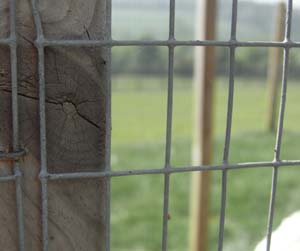 When buying a run, you will need to look at the quality of the wire – small rectangular or square mesh wire is better because foxes can’t get their teeth in to tear at it.
When buying a run, you will need to look at the quality of the wire – small rectangular or square mesh wire is better because foxes can’t get their teeth in to tear at it.
Cheap rabbit wire can be quite thin (especially the cheaper, imported versions from Asia) and I have seen this torn open in weak spots, sadly enough for Mr. Fox to get through. If you decide to use rabbit wire then look for British made, galvanised wire. You certainly ‘get what you pay for’ here but it’s worth doing the job properly.
Latches or bolts to doors are important as well. Galvanised fittings will last years so it is worth paying for these. Screws need to be stainless steel so they don’t rust.
Foxes will dig under a chicken run. If you have problems with foxes during the daytime (or your chickens are not securely locked up in their house at night) then you will need to consider putting your run onto bricks so that Mr. Fox can’t dig underneath. You can put wood chips down inside the run so they can be changed regularly.
There are some smaller runs available that might be customisable to your coop.
Building a Chicken Run
If you are going to build a chicken run, you will need to spend less money but more time. You can of course build a small portable run, much like you would buy and the same things apply to this as I’ve mentioned above but often, people that are building a run go for a fixed run in the corner of the garden.
Rabbit wire is the most economical choice but do be careful with the quality of it. If it isn’t particularly thick, a determined fox will be able to tear at it to get in. a double layer around the lower half of the fence is best if the wire quality is poor.
Ensure that weak points such as where wire joins houses is securely stapled. These areas will need checking regularly for signs of wear and tear. If installed correctly, electric fences are very good at keeping foxes out but on occasions, I’ve seen a run with a fox unable to get out! Sadly the damage has already been done.
Electric fences are not always suitable for every back garden but even in an urban environment where there are people, you can use an electric wire around the top of a fence to stop foxes climbing over.
Chicken wire needs to be burried at least 6 inches with another couple of inches turned outwards but if the soil is loose, you may need to go down 9 inches or more.
A fox can run up a fence (don’t think of a fox being like a dog, they can move more like a cat and can jump and climb really-well) so unless your run has a wire roof, you will need to make the fence at least 6ft high and ideally sloping outwards at the top.
Gates should ideally be made from a solid mesh stapled to a sturdy frame. If this is not possible, at least make sure the gate cannot twist, allowing a predator to get through if pushed in the corners. A fox will easily get through a small hole. If you don’t believe me, go to my page on foxes and watch the film of the fox squeezing under the fence that’s just a few inches off the ground!
Another method of building a large chicken run is to build some ‘chicken run panels’. You can cut all of your wood in one go, with many pieces being the same size. Once you have produced enough panels, you can screw them together making a large run that’s easy to assemble. Keep the panels off the ground so they don’t rot, a brick base on a small strip foundation is perfect but I’ve seen people use rectangular posts on their side and (better) old railway sleepers buried in the ground.
How to Build a Chicken Run
Building a chicken run is really straight forward if you have some basic DIY skills and follow some of the guidance I have given above.
There are a number of chicken run designs that manufacturers use and a few other ‘home made’ runs that are successful. It is difficult to say when a chicken run becomes a ‘fenced off area’ (see my page on fencing chickens if you have a large area to fence off as a run). I tend to call both ‘the chicken run’.
Here, I am going to call the ‘chicken run’ an enclosure that could be 3 to 4 meters long, usually attached to the coop, rather than being ‘around’ the coop and is often covered over.
Start by drawing up the run how you see it in your mind. I like to make notes on my drawing as things pop into my head. This can save you significant time later on if you have thought it through before buying and cutting wood.
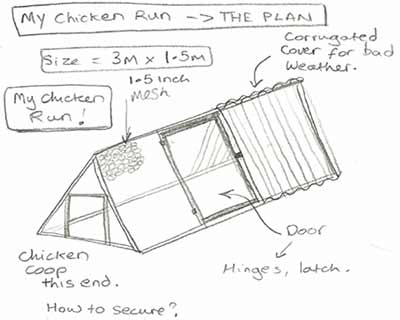 Draw a ‘close up’ of how you are going to make the joints of the chicken run, doors, joint wire and so on.
Draw a ‘close up’ of how you are going to make the joints of the chicken run, doors, joint wire and so on.
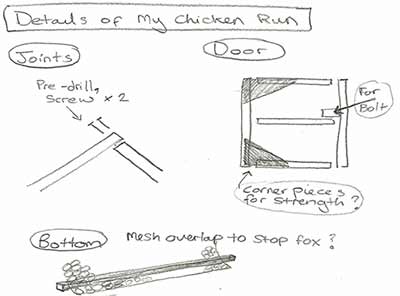 Build a ‘cutting list’ of pieces you will need to build the chicken run. Turn this into a ‘shopping list’ by working out how long your wood needs to be and what sort of thickness you will need. Add hinges, latches, screws, nails, poultry netting and staples to this.
Build a ‘cutting list’ of pieces you will need to build the chicken run. Turn this into a ‘shopping list’ by working out how long your wood needs to be and what sort of thickness you will need. Add hinges, latches, screws, nails, poultry netting and staples to this.
Go and buy your materials, allowing a small amount extra for mistakes!
Chicken Run Plans
One of the best sources of information on chicken runs has been looking through old poultry text books from the 1900’s onwards. These often give chicken house and run plans that have stood the test of time. Many have fold out pages with the plans on so providing you are happy to work in inches and feet, for a couple of searches on eBay and a few pounds, you can soon have quite a few chicken run plans.

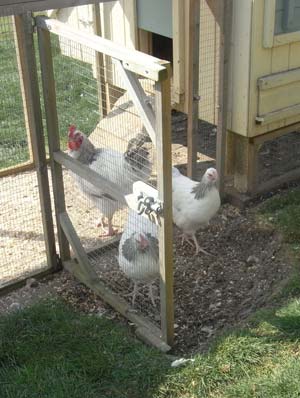
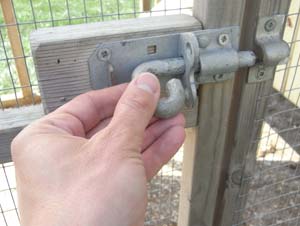



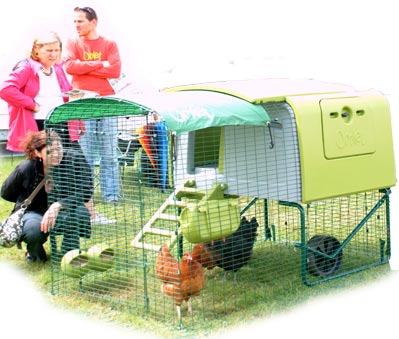


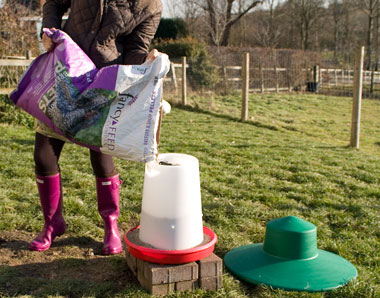
Great site! Having lost all my chickens to a fox, I am in the process of building a large run on a concrete base suronded sides and top with wire. (Top tip by the way re the rectangular chicken wire). The run will have drainage for ease of cleaning as the six new girls will be sharing with two ducks. It is very large indeed so alot of space for them all. Can you please advise as to what I should lay on the concrete that is suitable for both the chickens and the ducks? I would like something both will find interesting to root through and idealy something I can compost easily when changed as it will be mixed the their waste. Thanks for your time.
I would go for wood chippings (not bark as it can contain mould spores) as this will last some time and will compost eventually (takes a couple of years though). Sand is best avoided as ducks like to dabble and will pick up too much that can get stuck in the bill.
Hi, Fab site, thank you. I have wanted chickens for a long time but our garden is not suitable to house them as we have a lurcher! Someone in the village is currently selling a chicken house and adjoining 8ft coop and I am wondering whether it is possible to put it out by our garage on our parking area (which is part of a field owned by somebody else) which has a soil base but I could cover with woodchips. Ideally I would like to let them out for a couple of hours to scratch about and I assume they would go into the field to get the grass. I don’t like the idea of keeping them in a run all the time to get bored and start hen pecking. How far do they tend to roam from their house? We live on the main hill into the village so don’t want them getting run over or disappearing out into the top corner of the field where the foxes roam!
As chickens originate from the Jungle Fowl, they like cover overhead from predators so don’t like wandering into an open field as much as being close to hedges and other ‘cover’. Generally they will stay fairly close to their house for security but if there is cover, or food, they may wander a little further. It also depends on the breed. I had some Black Rock hybrids that would wander across the field to the hedgerow to forage but Buff Orpingtons that sat around the house all day!
Hi, we have just taken three ex battery chickens from a family member who could no longer look after them, we have a lurcher! We introduced her to the chickens on the lead and she is now not bothered by them. We have a coop and nesting box and strung to together a run out of fine gauge wire, they have destroyed the lawn and its now a mud bath but once the weather is better we will be able to put some other material down. We are getting eggs every day and we love them despite the mess!
Hi,
I have just bought a chicken coop and would like to treat the wood with a wood preserver. what would you recomend and would it be advisable to also paint the inside.
I have also read your very informative page on the pesky red mite. Would it be a good idea to use the liquid and powder straight away in my new coop or wait until signs of red mite appear
There are a number of wood treaters and preservers available. I would choose one, then look for the customer services number on the back and call them to check that it is animal friendly. Yes, I would start dusting the coop for Red Mite from the start but only in the warmer months as they aren’t active in the cold.
Hi, I’ve jsut come across your pages today and I’m hoping you can help me in my quest to get some chickens.
I have a garden with 6ft high fencing. I am hoping to get some chickens, but as I don’t have a huge garden, I’m hoping I can house them and keep their run in one area. I hve heard that runs need to keep being relocated to prevent infection spreading, something to do with chickens living on their own mess. I don’t have a large enough garden to give them a number of different locations and still have areas for my children to play.
Is it feasable to give them the bottom of the garden and cover the grass with wood chippings and replace these periodically to prevent infection? I would like to allow them into the garden for a couple of hours in the day when I’m not at work (I work 3 days a week).
The area I’m thinking of to house the run and coop would be 10x6ft and I’m thinking of getting 3 chickens
Yes, it sounds feasible in that area. It’s worms that are the most likely problem when keeping chickens on the same ground. Wood chippings that can be changed will certainly help.
We have a coop and 12 chickens in our backyard in. Brooklyn, NY. The run is on a concrete slab that had a layer of sod-like ground cover until my wife dug it up. Now it’s just lose hay over the concrete and I wonder if that’s okay for them especially in the winter? The ground cover also seemed like a nice cushion an I wonder if that’s a benefit or a draw back to their run?
Thanks for any insight!!
Ak
No, hay is not a good choice. It can harbour mould spores and soon compacts. Leaves, wood chippings or sand / gravel is a better choice.